Written by Zhujun Ma, Brown University
The FROGBEAR Cluster 1.5 “Extended Textual Communities” is a seven-day field visit that explored how reading, writing, printing, and circulating Buddhist canons transnationally structured and defined the extended textual communities of real or imagined readers in China and Japan. The field visit took place in Kyoto, Uji, and Nara in Japan from July 24 to July 30, preceded by two pre-meetings (July 12 and 23, respectively) for team members to familiarize themselves with each other, field work agenda, and metadata submission rules. The formal program consisted of two lectures on the Ōbaku Canon (Ōbakuzō 黃檗藏) and multiple guided tours in some of the most important temples in Japanese Buddhism. Participants made full use of this rare opportunity to closely examine the printing blocks of the Ōbaku Canon stored in Hōzōin Cloister 寶藏院, in Ōbaku-san Manpuku-ji Temple黄檗山萬福寺 (Uji, Japan). They investigated the architecture, monastic culture and history of the Ōbaku tradition in Manpuku-ji Temple, photographed and documented the wooden plaques and couplets in Manpuku-ji Temple, and extensively explored Buddhist temples and transnational Buddhist history in Kyoto, Uji, and Nara.
The cluster was led by Professor Jiang Wu 吳疆 (University of Arizona), an expert in Chinese Buddhist canons, and the historical exchanges between Chinese and Japanese Buddhism in the seventeenth century. The agenda arrangement was co-organized by Dr. James Baskind (University of Arizona), an expert in the Ōbaku tradition and Japanese Buddhism, which offered rare opportunities for the participants to communicate with local monks in Manpuku-ji Temple. Participants of this year’s cluster included faculty members and graduate students from University of Arizona, University of British Columbia, Dharma Drum Institute of Liberal Arts, McGill University, Columbia University, University of Chicago, École Pratique des Hautes Études-PSL, Ewha Womans University, Princeton University, Temple University, the Chinese University of Hong Kong, University of Glasgow, John Abbott College, Brown University, and Edinburgh University.
On July 12, Prof. Wu held a preliminary virtual meeting to introduce the cluster agenda and answer questions. The participants shared their background, research interests, and motivations for joining the cluster. Prof. Wu briefly introduced the history of Ōbaku tradition and elaborated on the daily arrangements of the field plan. Later, the participants watched a pre-recorded greeting video by Dr. Baskind. Dr. Baskind coordinated the arrangement with monks of the Manpuku-ji Temple but was unable to join the cluster in person. Lastly, Jeffrey Liu 劉瑋, a PhD candidate at the University of Arizona, demonstrated the general process of data collection and documenting. Participants also received a link to the data collection tutorial by FROGBEAR for reference after the meeting.
On the evening of July 23, all the participants landed in Japan and met in person in front of Higashi Hongan-ji Temple 東本願寺 for a second unofficial preparatory meeting. Prof. Wu discussed the plans for July 24 and offered suggestions for ground transportation. For the remainder of the evening, participants joined in icebreakers, reintroduced themselves, and freely chatted with each other.
On the morning of July 24, the cluster participants had an in-depth tour of the Manpuku-ji Temple guided by Master Tanaka Chisei 田中智誠, the Director of Bunkaden 文華殿, Manpuku-ji Temple, and translated by Jia Guangzuo 賈光佐 (PhD candidate, Tohoku University). Master Tanaka walked participants through the different halls, tombs, plagues, calligraphy, and decorations of the temple. Chinese Chan Master Yinyuan Longqi 隱元隆琦 (Jpn. Ingen Ryūki, 1592–1673) traveled to Japan and founded the Manpuku-ji Temple in Uji, Kyoto in 1661, which was named after the Wanfu Temple 萬福寺on Mount Huangbo 黃檗山 in Fuqing, Fujian Province, China. Master Tanaka further directed participants’ attention to the different decorations and their cultural allusions. He demonstrated how the arrangement of Manpuku-ji buildings symbolized the image of a dragon. He also told vivid local stories of Ingen Ryūki, his Japanese disciple Tetsugen Dōkō 鐵眼道光 (1630–1682), and his teacher Feiyin Tongrong 費隱通容 (1593–1661), that had been passed down over the years in the temple. Cluster participants were fascinated by the close ties between the lived traditions in Japanese monastic communities and Chinese Buddhist history.
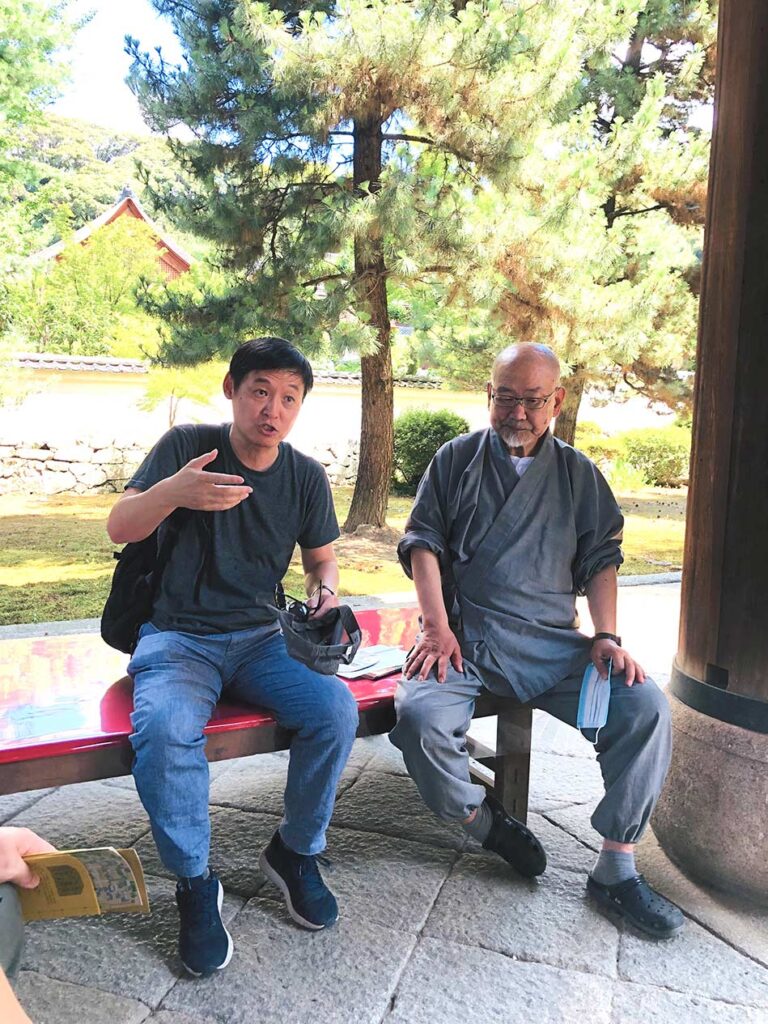
Figure 1. (From left to right) Prof. Jiang Wu and Master Tanaka Chisei introducing the history of Manpuku-ji to participants. July 24, 2023. Photo by Jeffery Liu and Ziling Wan. Republished with permission.

Figure 2. Group photo of cluster participants and Master Tanaka in front of the DaiyūTreasure Hall in Manpuku-ji Temple. July 24, 2023. Photo by Jeffery Liu and Ziling Wan. Republished with permission.
After the lunch break, participants gathered in the Yellow Dragon Pavilion 黃龍閣, Manpuku-ji Temple, for a lecture on Japanese Buddhist book history and the Ōbaku Canon by Professor Matsunaga Chikai 松永知海 (Bukkyo University). Prof. Wu introduced Prof. Matsunaga’s expertise, accomplishments, and his long-time devoted efforts working on the Ōbaku Canon. The lecture was translated by Jia Guangzuo and Chien-Cho Chan (PhD student, University of British Columbia). Prof. Matsunaga started his lecture with Tetsugen Dōkō’s vow of printing and circulating Buddhist canon to offer solace for the suffering of people. Prof. Matsunaga further compared the printing technology, material details, and social influence of the Ōbaku Canon (the Tetsugen edition) and the earliest Buddhist canon in Japan printed by a Tendai monk Tenkai 天海 (?–1643). Unlike the Tenkai Canon that had limited copies due to movable type technology, the Ōbaku Canon was mass printed and broadly circulated thanks to carved woodblocks and booklet binding format (fangce ben 方冊本). Prof. Matsunaga also showed a video demonstration of the printing process and introduced the material details of the printing blocks. Additionally, Prof. Matsunaga shared his article with the participants for further reference on a systematic review and details about the Ōbaku Canon. During the Q&A session, participants asked about the historical influence, circulation, and current preserving condition of the Ōbaku Canon.

Figure 3. Prof. Matsunaga Chikai explaining the difference between the movable type printing technology and the whole-set woodblock printing technology. July 24, 2023. Photo by Jeffery Liu and Ziling Wan. Republished with permission.

Figure 4. Participants listening to Prof. Matsunaga Chikai on details in the video of the printing-demonstration process. July 24, 2023. Photo by Jeffery Liu and Ziling Wan. Republished with permission.
On the morning July 25, cluster participants first attended a lecture by Prof. Watanabe Mariko 渡辺麻里子 (Taisho University) in the Yellow Dragon Pavilion, Manpuku-ji Temple. Prof. Wu introduced Prof. Watanabe’s research on Japanese Buddhism and medieval Japanese literature. The lecture was translated by Jia Guangzuo and Chien-Cho Chan. Prof. Watanabe began the lecture by noting that she referred to the Ōbaku Canon printed by Tetsugen Dōkō as the Tetsugen Canon to highlight his contribution. Then Prof. Watanabe introduced the printing history of the Tetsugen Canon by explaining the fund-raising and editing process. She emphasized that the Tetsugen Canon’s broad transmission enabled and promoted the emerging notion of collating Buddhist canon by comparing different editions in Japanese Buddhist history. Additionally, Prof. Watanabe introduced another Ōbaku monk, Ryōō Dōkaku 了翁道覚 (1630–1707), who contributed significantly to the circulation of the Buddhist canon and to the promotion of monastic education in medieval Japan. Prof. Watanabe pointed out that Ryōō Dōkaku continually donated different editions of the Buddhist canon to major temples of Tendai, Zen, and Shingon traditions during his lifetime. He also constructed monastic academies (kangakuryō 勧学寮) for monks to study Buddhist texts. Lastly, in the Q&A session, Prof. Watanabe answered questions about the academic influence of the Tetsugen Canon on the history of Japanese Buddhist studies.

Figure 5. Participants listening to Prof. Watanabe Mariko’s lecture on the Ōbaku Canon. July 25, 2023. Photo by Jeffery Liu and Ziling Wan. Republished with permission.

Figure 6. Prof. Watanabe Mariko explaining the textual history of the Tenkai Canon, Tetsugen Canon, and Ōbaku Canon. July 25, 2023. Photo by Jeffery Liu and Ziling Wan. Republished with permission.
After the lecture, cluster participants enjoyed vegetarian (fucha普茶) lunch boxes in the Manpuku-ji Temple. During lunch, Prof. Wu notified participants that the available photographing time was adjusted to take place only on the morning of July 26 because an initiation ritual would take place in the temple. Participants were welcome to attend if interested. Having read about and visiting the Manpuku-ji Temple on the first two days, participants actively formed five small groups to photograph different areas according to their research interests. Group members discussed and adjusted their photography plans accordingly.
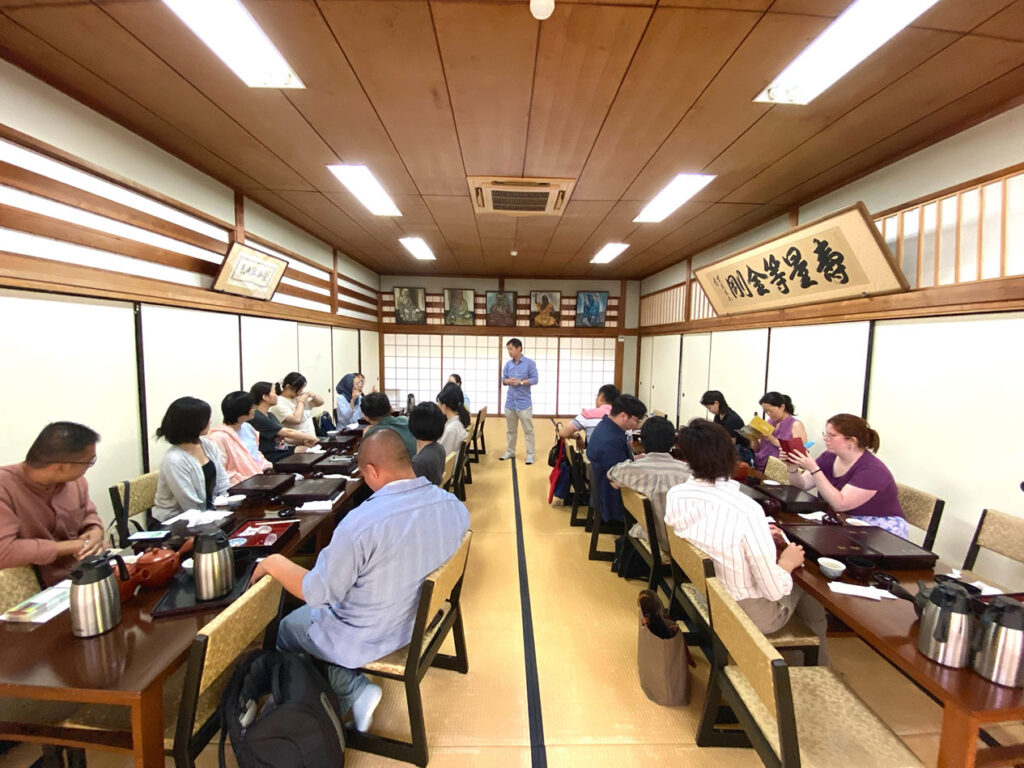
Figure 7. Prof. Wu answering questions about photographing and collecting data after participants enjoyed vegetarian lunch boxes. July 25, 2023. Photo by Jeffery Liu and Ziling Wan. Republished with permission.
In the afternoon, participants visited the Hōzōin Cloister to examine the printing blocks of the Ōbaku Canon along with Prof. Watanabe. The abbot of the Hōzōin Cloister, Master Morii Kōdō 盛井幸道, gave a welcome speech to introduce the history of the Hōzōin Cloister and the Ōbaku Canon. The Hōzōin Cloister was first constructed in 1669 to print the Tetsugen Canon and store the carved woodblocks. The Cloister currently holds 60,000 blocks, which are recognized as Important Cultural Properties (jūyō bunkazai 重要文化財) by the Japanese government’s Agency for Cultural Affairs (Bunka-chō 文化庁). Master. Morii also highlighted the material features of the woodblock and printing paper, and summarized the Ōbaku Canon’s influence on Japanese culture and Buddhist communities. Prof. Wu commented that this tour guided by Master Morii is a precious opportunity for cluster participants to study texts in the monastic context. During the tour, Master Morii showed participants the texture of different kinds of printing paper used to print the Tetsugen Canon. The format and layout of the paper led to the standardization of the manuscript paper (genkō yōshi 原稿用紙) during the Edo and Meiji periods. He also used handheld lamp to highlight the details of woodblocks. Thanks to the guidance of Master Morii, Prof. Wu, and Prof. Watanabe, participants further examined and inquired more about the Ōbaku Canon on-site. After the guided tour on woodblocks, participants were invited to the Hōzōin Cloister to explore published references on the Ōbaku Canon, including catalogs. Mr. Morii also demonstrated chanting the Heart Sūtra. Thanks to the close interaction with the monastic community in the Hōzōin Cloister, participants gained a better understanding of how the extended textual communities in Japan practiced the printing and preserving the woodblocks.
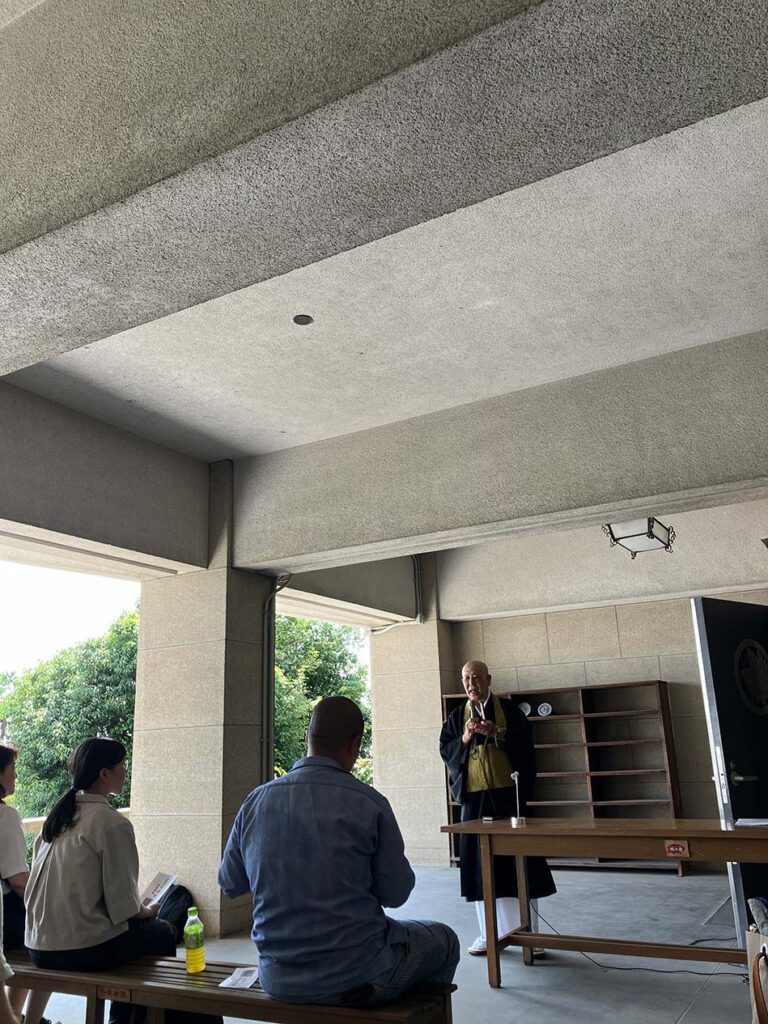
Figure 8. Master Morii Kōdō giving a speech on the history of Hōzōin Cloister and the Ōbaku Canon. July 25, 2023. Photo by Zhujun Ma. Republished with permission.
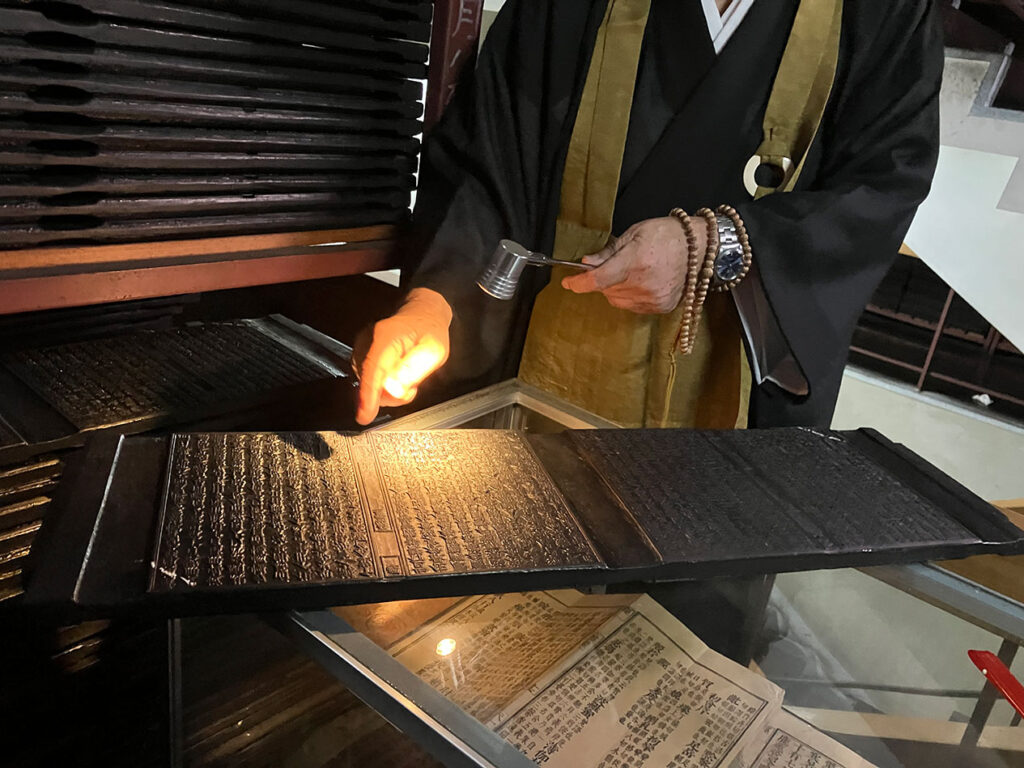
Figure 9. Master Morii Kōdō showing details of a woodblock in Hōzōin Cloister. July 25, 2023. Photo by Zhujun Ma. Republished with permission.
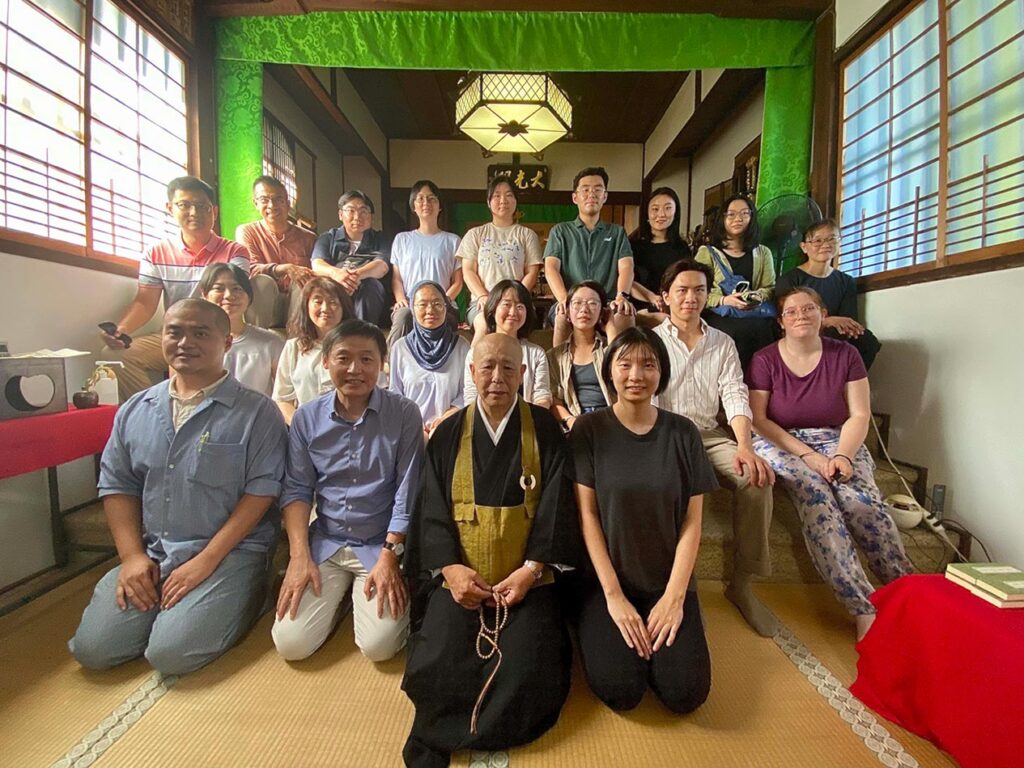
Figure 10. Group photo of cluster participants, Prof. Wu, and Master Morii Kōdō in Hōzōin Cloister. July 25, 2023. Photo by Jeffery Liu and Ziling Wan. Republished with permission.
On the morning of July 26, the cluster participants photographed and documented the wooden plaques in different areas of the Manpuku-ji Temple. Participants divided into five groups to photograph the Third Gate (Sanmon 三門), Main Gate (Sōumon 總門), Founder’s Hall (Kaisandō 開山堂), Eternal-Life Stūpa (Jutou 壽塔), Hall of the Guardian Kings (Tenōden 天王殿), Zen Hall (Zendō 禪堂), Daiyū -Treasure Hall (Daiyū-hōden大雄寶殿), Abstinence Hall (Saidō 齋堂), and Dharma Hall (Hattō 法堂). Participants carefully documented the actual condition and exact location of each wooden plaque. Later, each group arranged their documentation and submission plan respectively to provide necessary references and transcriptions of the Chinese in the metadata and descriptions. Some groups were lucky enough to encounter Master Tanaka during their session who later opened some closed-off areas of the temple. Those participants not only photograph at closed-off areas but were also invited to Bunkaden to read renovation reports on Manpuku-ji architecture and publications on the Ōbaku Canon for reference.

Figure 11. Participants cooperatively photographing wooden plaque of the Daiyū-Treasure Hall. July 26, 2023. Photo by Jeffery Liu and Ziling Wan. Republished with permission.
In the afternoon, the cluster visited Byōdō-in平等院 in Uji. This temple was initially constructed in the Heian period 平安時代 (794–1192). It is one of the World Heritage sites of Japan. Participants first had a guided tour to visit the interior of the Hōō-dō 鳳凰堂 (Phoenix Hall), which is the only remaining original building after a fire during a civil war in 1336. The Phoenix Hall preserves a seated statue of Amitabha Tathāgata in a twofold canopy. This statue was created by Jōchō 定朝 (–1057), allegedly the best Buddhist sculptor in the Heian period. Afterward, participants visited the Hosho-kan Museum 鳳翔館. Here, participants closely appreciated the splendid details of a pair of phoenix statues that was originally displayed on the roof of the Phoenix Hall. Among the 52 statues of Praying Bodhisattva on Clouds originally in the Phoenix Hall, 26 were exhibited with detailed explanations in Hosho-kan Museum. The exhibition brought the cluster participants to the world of the Pure Land Buddhist art and architecture in the Heian period.
On July 27, some interested cluster participants attended the initiation ritual in the Manpuku-ji Temple in the morning. In the afternoon, the cluster visited the Tōfuku-ji Temple 東福寺. At the beginning of the tour, Prof. Wu introduced the history of the Tōfuku-ji Temple, whose name comes from Tōdai-ji Temple 東大寺 and Kōfuku-ji Temple 興福寺. It joined the Kyoto Five Mountain System (Kyoto Gozan 京都五山) during the Muromachi period 室町時代 (1333–1573). Prof. Wu directed students to pay particular attention to the dragon image at the ceiling of the Main Hall and be aware of the multiple renovations of the Tōfuku-ji architecture throughout history. Prof. Wu also pointed out that the wooden plaque of the Zen Hall was inscribed by the renowned Chan Master and calligrapher Wuzhun Shifan 無准師範 (1178–1249) from the Southern Song dynasty 南宋 (1127–1279). After visiting different architecture and the Tōfuku-ji Museum, participants delightfully appreciated the well-known Japanese dry garden (karesansui 枯山水), “Hasso” Garden 八相之庭, and the Tsūtenkyō Arch通天橋 for an immersive break in the Zen garden and green maple leaves.

Figure 12. Group photo of participants in front of the Main Gate of the Tōfuku-ji. July 27, 2023. Photo by Jeffery Liu and Ziling Wan. Republished with permission.
On July 28, the cluster traveled to Nara to further explore the Japanese Buddhist art and history in the Heian period. The cluster visited the Tōdai-ji Temple 東大寺 in the morning. Prof. Wu pointed out that the size of the mountain gate (sanmon山門) in Tōdai-ji was unusually big, which indicated the spacious scale of Chinese temples in the Tang dynasty 唐 (618–907). In the optional afternoon, the cluster participants freely explored the recommended Hōryū-ji Temple法隆寺, the Tōshōdai-ji Temple 唐招堤寺, and the Nara National Museum 奈良國立博物館 according to their interests. Two master’s students from Ewha Womans University, Minkang Park and Sunhyun Park kindly invited a friend working on art history in the Hōryū-ji Temple to offer a guided temple tour for interested participants from 3 to 5pm.
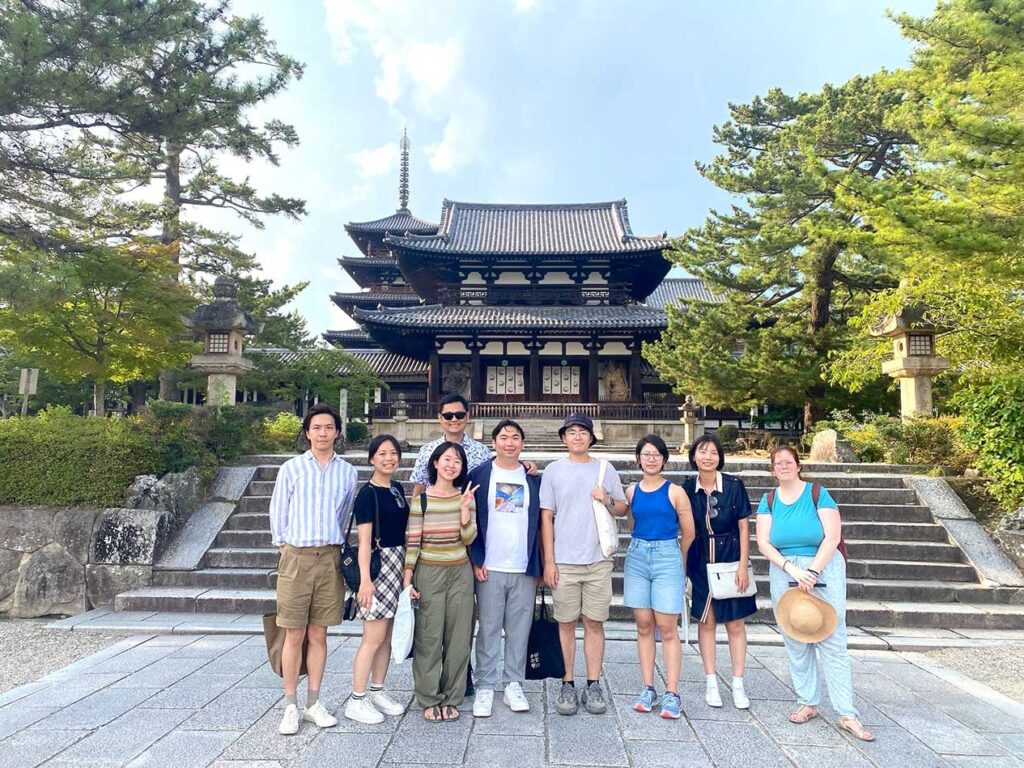
Figure 13. Group photo of some participants who attended the optional guided tour in Hōryū-ji. July 28, 2023. Photo by Jeffery Liu and Ziling Wan. Republished with permission.
The cluster agenda officially ended on July 28. The cluster participants continued to explore Buddhist sites in Kyoto and to work on data submissions on July 29 and 30. On the night of July 29, the cluster gathered to have a farewell dinner at the Kyoto station. Participants gracefully thanked the efforts of Prof. Wu and his two students, Jeffrey Liu and Ziling Wan (PhD candidates, University of Arizona). The trip was well-designed for participants to have first-hand experience in exploring Buddhism and Japanese art. It offered a rare opportunity for student participants who access to the Ōbaku collection or monks’ guiding service that they normally would not be able to do so when the visiting temples. The featured lectures offered systematic knowledge about Japanese Buddhist canon and print culture to prepare students before the examination of the woodblocks. The lunch time with the lecture speakers and fellow participants allowed students to further elaborate on questions and topics that they raised from the lectures and field visits. Participants also gained friendships with fellow grad students from different disciplines by closely working with team members on photographing and documenting data.
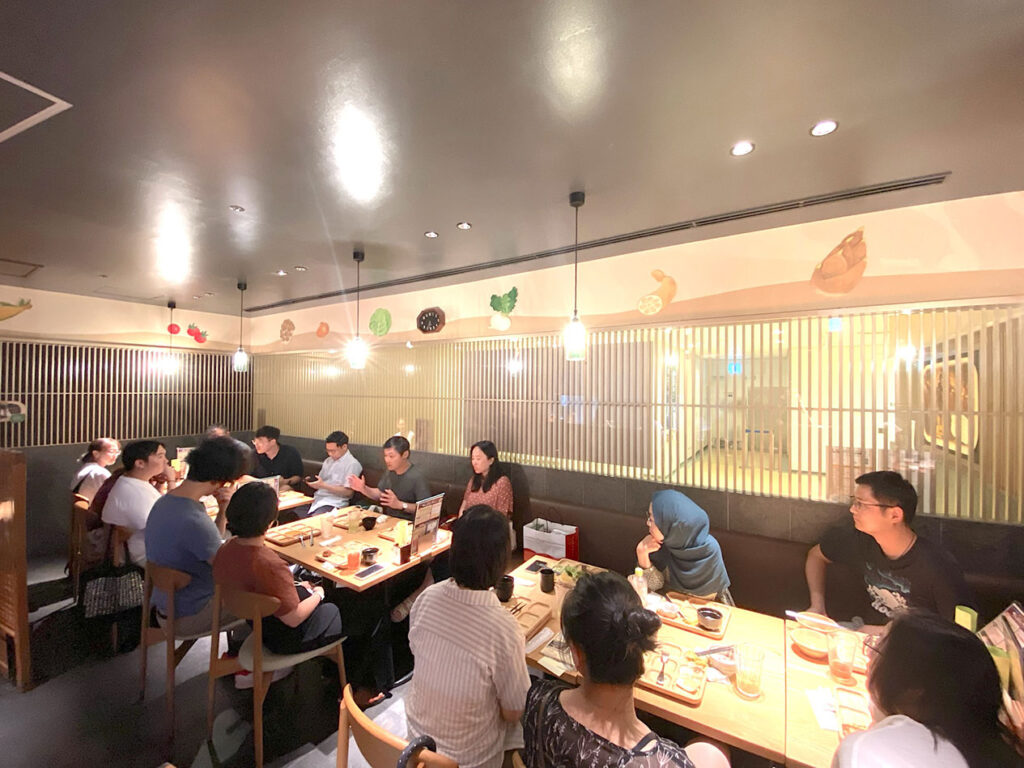
Figure 14. Participants listening to Prof. Wu’s comment on the cluster trip during the farewell dinner. July 29, 2023. Photo by Jeffery Liu and Ziling Wan. Republished with permission.
Author Bio:
Zhujun Ma 馬竹君 is a PhD student in Religious Studies, Brown University. She earned her BA in Chinese Languages & Literature from Zhengzhou University, a MA degree in Chinese Folk Literature from Shandong University, and her Dual MA in Religious Studies and Asian Languages & Civilizations from the University of Colorado Boulder. Her research mainly focuses on gender, book history, and Chinese religions from the sixteenth to early twentieth centuries. She is currently working on pilgrimage practices and female religiosity in the cult of the Goddess of Mount Tai, cheaply printed pilgrimage maps of Mount Jiuhua and knowledge production in Shanghai and Anhui, and the idea of female salvation in the publishing practices related to the Blood Bowl Sutra.
Click here for the original posting
* This report has been updated to reflect name change of a participant at their request.







